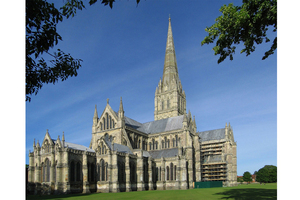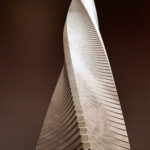The Spire, published in 1964, is the fifth novel authored by author William Golding, who is by far best known for his first–Lord of the Flies.
The story–which is pretty sparse; this is decidedly not an eventful, fast-paced book–concerns the obsession of the head priest of a church (Dean Jocelin) to have a monstrously large spire added to his church. The builders protest that it will be impossible to build what he wants in a way that will be structurally sound, and the other church officials protest that this is a disruptive and distracting use of time and resources that is taking away from their religious duties. But Dean Jocelin insists that his quest is inspired by God and that the very fact that it has such drawbacks is what makes believing in it and sticking to it all the more admirable a show of faith.
Much of the novel is told from within the mind of Dean Jocelin, and it gradually becomes clear that he is at least somewhat (and probably increasingly) mad, that he is very sincere, and that he is trying to overcome a considerable amount of self-doubt and guilt.
It also is apparent there is little he won’t do to get his spire built. Albeit with great reluctance and self-questioning, when he sees that the master builder is leaning toward pulling out, he welcomes the fact that the builder is then distracted and encouraged to stick it out by his commencement of an affair with a young and naive wife of a church worker. Further complicating things emotionally for Dean Jocelin is the fact that this is a young woman he has felt close to since she was a small child, and has gradually developed an attraction to that is pretty clearly sexual, even as he tries to fight that interpretation.
The Spire is the kind of novel that drops you in the middle of things without any background or introduction, where you have to gradually piece together who these people are and what they’re doing from the events and dialogue depicted. Which is a style that, for me at least, can be frustrating depending on how it’s handled.
And here it’s handled in such a way that evidently I missed plenty, at least judging from what I discovered when I read about the book afterwards in various sources. Here’s a partial list of what got past me:
* It is set in the 14th century.
It didn’t “feel” contemporary to me from fairly early on, but I didn’t pick up on enough specifics to be able to date it precisely at all. I would have said anywhere between about 600 and 1900, I suppose.
* It is set in England.
Based on the names and such, maybe that would have been my first guess. So I wasn’t surprised to read that later, but it’s not like this is something I was sure of from reading the book.
* Though it’s not based on any known historical events, it’s vaguely about, or at least inspired by, Salisbury Cathedral near where Golding lived in real life.
I’m pretty sure there’s zero way to know this from the book.
* Dean Jocelin is suffering from tuberculosis.
Well, he seems convinced there’s alternately an angel or a devil communicating with him, and it seems to somehow be located on his back, giving him comforting warmth or pain there. How you get tuberculosis out of that I’m not sure.
* One of the semi-main characters ends up being murdered and buried by the workers where the construction is going on, as some sort of superstition thing.
This one may not count, since another source says this character’s fate is left open and that different people have interpreted it different ways. In any case, he does disappear from the book, and in an ominous way I suppose, but I didn’t get anything specific like this.
The novel is mildly interesting as an exploration of the pros and cons of committing so deeply to something that you’re willing to stick with it no matter the evidence, no matter the opinions of others. When you believe in yourself and your life projects more than might seem justified, you can potentially achieve great and unexpected things. But of course there’s a fine line between that kind of confidence and reckless irrationality.
Religion has no doubt added more of both kinds of phenomena to the world than there otherwise would have been, but I dare say far more of the second, undesirable, kind.
If one is of a mind to, I’m sure there is much symbolism in this novel one could speculate about. Perhaps you see the spire as the Tower of Babel, or a phallus, for instance. I’m not going to pretend to be qualified to address such matters, as I’m more inclined to seek value in the substance of a story in a much more straightforward way. In that regard, I liked certain aspects of The Spire, such as the psychological interplay among some of the characters and within the tortured and deteriorating Dean Jocelin, but for the most part I found the novel to be a slow, sluggish read, and too obscure for my tastes.



